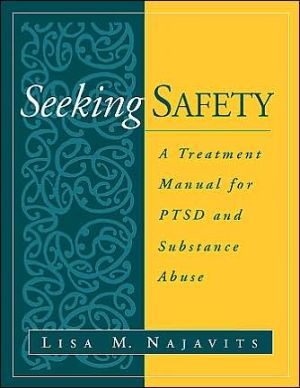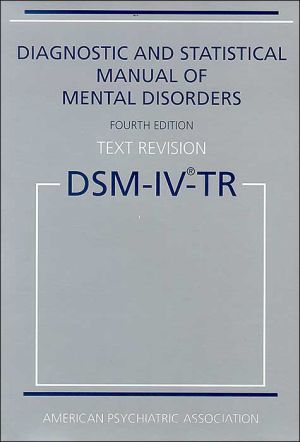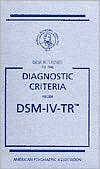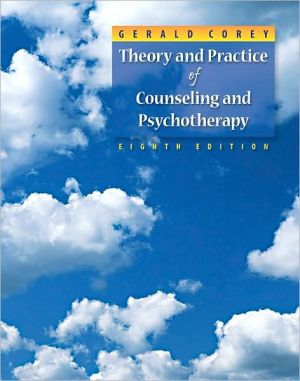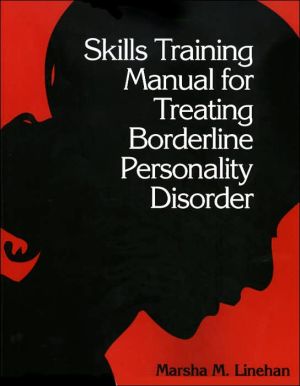Seeking Safety: A Treatment Manual for PTSD and Substance Abuse
This manual presents the first empirically studied, integrative treatment approach developed specifically for PTSD and substance abuse. For persons with this prevalent and difficult-to-treat dual diagnosis, the most urgent clinical need is to establish safety--to work toward discontinuing substance use, letting go of dangerous relationships, and gaining control over such extreme symptoms as dissociation and self-harm. The manual is divided into 25 specific units or topics, addressing a range...
Search in google:
This manual presents the first empirically studied, integrative treatment approach developed specifically for PTSD and substance abuse. For persons with this prevalent and difficult-to-treat dual diagnosis, the most urgent clinical need is to establish safety--to work toward discontinuing substance use, letting go of dangerous relationships, and gaining control over such extreme symptoms as dissociation and self-harm. The manual is divided into 25 specific units or topics, addressing a range of different cognitive, behavioral, and interpersonal domains. Each topic provides highly practical tools and techniques to engage patients in treatment; teach "safe coping skills" that apply to both disorders; and restore ideals that have been lost, including respect, care, protection, and healing. Structured yet flexible, topics can be conducted in any order and in a range of different formats and settings. The volume is designed for maximum ease of use with a large format, lay-flat binding, and helpful reproducible therapist sheets and handouts. Doody Review Services Reviewer:Lavinia L. Myers, MD(Rush University Medical Center)Description:This interesting book on the treatment of patients with a dual diagnosis of PTSD and substance abuse presents a structured therapy format based on the author's own research.Purpose:The purpose is to provide a directive, specific treatment modality for patients who suffer from both post-traumatic stress disorder and substance abuse. This is an area about which little is written; specific treatments addressing both problems are few. It attempts to give therapists flexibility in using the materials it provides, with a modular design to its topics. Its objectives are timely and significant for the population with which it deals. The book meets its overall objective.Audience:Intended for psychotherapists in general, this book provides a step-by-step approach and extensive suggested reading for additional training in specific areas. It will be useful to therapists dealing with patients in a variety of settings, from inpatient to group to individual therapy. The author has done extensive research in this area, and has received numerous awards and grants for her work.Features:The book includes multiple handouts, intended to be copied and used within the therapy. These are attractive as well as practical. The reference list is thorough and up-to-date, with suggestions for further learning.Assessment:This is an excellent book for psychotherapists treating patients with PTSD and substance abuse. It provides a step-by-step guide to structured therapy in an area in which little is written. It helps fill the need for more dual-diagnosis oriented therapy.
Seeking Safety\ A Treatment Manual for PTSD and Substance Abuse \ \ By Lisa M. Najavits \ The Guilford Press\ Copyright © 2002 The Guilford Press\ All right reserved.\ ISBN: 1-57230-639-4 \ \ \ \ Chapter One\ Overview\ PTSD AND SUBSTANCE ABUSE\ PTSD and Substance Abuse: Patients' Perspective\ "The more I use, the more I won't feel anything. The pain is so bad you just want to die. There is no other way out. If you talk about it, it will hurt too much. So instead, keep it a secret. No one will know."\ "When I was sober I was crazy, hiding under the bed."\ These patients have lived what is only beginning to be understood within the mental health and substance abuse fields-that posttraumatic stress disorder (PTSD) and substance abuse co-occur for a very large number of people, particularly women. Their stories also point to several major themes that are becoming increasingly recognized, based on clinical and scientific evidence:\ * The dual diagnosis of PTSD and substance abuse is surprisingly common. The rate of PTSD among patients in substance abuse treatment is 12%-34%; for women it is 30%-59%. Rates of lifetime trauma are even more common (Kessler, Sonnega, Bromet, Hughes, & Nelson, 1995; Langeland & Hartgers, 1998; Najavits, Weiss, & Shaw, 1997; Stewart, 1996; Stewart, Conrod, Pihl, & Dongier, 1999; Triffleman, 1998).\ * Becoming abstinent from substances does notresolve PTSD; indeed, some PTSD symptoms become worse with abstinence (Brady, Killeen, Saladin, Dansky, & Becker, 1994; Kofoed, Friedman, & Peck, 1993; Root, 1989).\ * Treatment outcomes for patients with PTSD and substance abuse are worse than for other dual-diagnosis patients and for patients with substance abuse alone (Ouimette, Ahrens, Moos, & Finney, 1998; Ouimette, Finney, & Moos, 1999).\ * People with PTSD and substance abuse tend to abuse "hard drugs" (cocaine and opiates); prescription medications, marijuana, and alcohol are also common. Substance abuse is often viewed as "self-medication" to cope with the overwhelming emotional pain of PTSD (Breslau, Davis, Peterson, & Schultz, 1997; Chilcoat & Breslau, 1998; Cottler, Compton, Mager, Spitznagel, & Janca, 1992; Dansky, Saladin, Brady, Kilpatrick, & Resnick, 1995; Goldenberg et al., 1995; Grice, Brady, Dustan, Malcolm, & Kilpatrick, 1995; Hien & Levin, 1994).\ * People with PTSD and substance abuse are vulnerable to repeated traumas (Fullilove et al., 1993; Herman, 1992), and more so than patients with substance abuse alone (Dansky, Brady, & Saladin, 1998).\ * People with both disorders suffer a variety of life problems that may complicate their clinical profile, including other DSM-IV disorders, interpersonal and medical problems, maltreatment of their children, custody battles, homelessness, HIV risk, and domestic violence (Brady, Dansky, Sonne, & Saladin, 1998; Brady et al., 1994; Brown & Wolfe, 1994; Dansky, Byrne, & Brady, 1999; Najavits et al., 1998c).\ * People with PTSD and substance abuse have a more severe clinical profile than those with just one of these disorders (Najavits, Weiss, & Shaw, 1999b; Najavits et al., 1998c).\ * Among patients in substance abuse treatment, this dual diagnosis is two to three times more common in women than in men (Brown & Wolfe, 1994; Najavits et al., 1998c).\ * Most women with this dual diagnosis experienced childhood physical and/or sexual abuse; men with both disorders typically experienced crime victimization or war trauma (Brady et al., 1998; Kessler et al., 1995; Najavits et al., 1998c).\ * PTSD and substance abuse have consistently been found to co-occur, regardless of the nature of the trauma or the type of substance used (Keane & Wolfe, 1990; Kofoed et al., 1993).\ * A "downward spiral" is common. For example, substance use may increase vulnerability to new traumas, which in turn can lead to more substance use (Fullilove et al., 1993). From patients' perspective, PTSD symptoms are common triggers of substance use (Abueg & Fairbank, 1991; Brown, Recupero, & Stout, 1995), which in turn can heighten PTSD symptoms (Brown, Stout, & Gannon-Rowley, 1998; Kofoed et al., 1993; Kovach, 1986; Root, 1989).\ * Various subgroups have high rates of this dual diagnosis, including combat veterans, prisoners, victims of domestic violence, the homeless, and adolescents (Bremner, Southwick, Darnell, & Charney, 1996; Clark & Kirisci, 1996; Dansky et al., 1999; Davis & Wood, 1999; Jordan, Schlenger, Fairbank, & Caddell, 1996; Kilpatrick et al., 2000; Ruzek, Polusny, & Abueg, 1998).\ * The connection between PTSD and substance abuse appears to be enduring, rather than simply an artifact of substance use, withdrawal, or overlapping DSM-IV criteria (Bolo, 1991; Kofoed et al., 1993).\ * Perpetrators of violent assault use substances at the time of assault in a high percentage of domestic abuse (50%) and rape (39%) cases (Bureau of Justice Statistics, 1992).\ PTSD and Substance Abuse: Therapists' Perspective\ The other half of the clinical equation is the therapist's perspective. One social worker in private practice said,\ "I used to feel that I wouldn't go near substance abuse patients with a 10-foot pole-I wouldn't treat them and was pretty judgmental of them. Mostly I didn't understand them. But when I became aware that many have a history of trauma I began to feel more compassionate. I realized how often they are self-medicating their pain."\ A psychiatrist on the substance abuse unit of a hospital said,\ "Where I work, patients are told to get off of substances first-only once they are clean can they deal with the trauma. They get four substance abuse groups a day but no groups for PTSD. Some of them feel invalidated, as though their trauma doesn't matter."\ Clinicians may feel confusion over how to treat such patients. For example:\ * "Should the patient talk about painful trauma memories during treatment?"\ * "Do I insist the patient must become substance-free before we work on the PTSD?"\ * "How can I contain a patient who becomes overwhelmed by PTSD symptoms?"\ * "Should I discontinue treatment if the patient keeps using substances?"\ * "Does psychotherapy for this population work?"\ * "Should I insist that the patient go to Alcoholics Anonymous (AA)?"\ Just as new knowledge has arisen about patients, new knowledge is also growing about treatment:\ * Most clinical programs treat PTSD or substance abuse, but rarely both. Yet an integrated model-treating both disorders at the same time-is recommended by both clinicians and researchers as more likely to succeed, more cost-effective, and more sensitive to patient needs (Abueg & Fairbank, 1991; Bollerud, 1990; Brady et al., 1994; Brown et al., 1995; Brown, Stout, & Mueller, 1999; Evans & Sullivan, 1995; Fullilove et al., 1993; Kofoed et al., 1993; Najavits, Weiss, & Liese, 1996c; Sullivan & Evans, 1994). Patients too favor integrated treatment of these disorders (Brown et al., 1998).\ * The majority of patients with PTSD and substance abuse do not receive PTSD-focused treatment (Brown et al., 1998, 1999).\ * Many patients are never even assessed for both PTSD and substance abuse (Fullilove et al., 1993; Kofoed et al., 1993). It is common for patients to report multiple substance abuse treatments during which they were never asked about trauma, never informed that they met the diagnosis of PTSD, and never told that PTSD is a treatable disorder for which specific treatments exist. Similarly, some mental health clinicians do not routinely assess for substance abuse.\ * It can be difficult to predict patients' course of recovery. Paradoxically, both abstinence and continued use of substances may make PTSD symptoms either better or worse, depending on the patient (Brown et al., 1998; Najavits, Shaw, & Weiss, 1996b).\ * Treatment can be effective, but is often difficult and may be marked by unstable treatment alliances, multiple crises, erratic attendance, and relapse to substance use (Brady et al., 1994; Brown, Stout, & Mueller, 1996; Root, 1989; Triffleman, 1998).\ * Both in the culture at large and among clinicians, views of patients with substance abuse and/or PTSD may be quite negative. Countertransference reactions are common (Herman, 1992; Imhof, 1991; Imhof, Hirsch, & Terenzi, 1983; Najavits et al., 1995). Patients are sometimes perceived as "crazy," "lazy," or "bad," both by others and by themselves.\ * Treatments that are effective for PTSD or substance abuse separately may not be advisable when the two disorders occur together. For example, PTSD treatments such as benzodiazepines or exposure therapy may not be indicated if a patient is addicted to substances; substance abuse treatment such as twelve-step groups may not work when a patient has PTSD (Ruzek et al., 1998; Satel, Becker, & Dan, 1993; Solomon, Gerrity, & Muff, 1992).\ * Patients with this dual diagnosis may have intensive case management needs, which may go beyond the training of some clinicians and sometimes lead to "burnout" (Najavits et al., 1996b).\ * The need for cross-training is common: The cultures, assumptions, and treatments for substance abuse and PTSD can be quite different, and most therapists do not have equal expertise in both (Evans & Sullivan, 1995; Najavits, 2000; Najavits et al., 1996c). Substance abuse counselors are not typically trained to work on severe mental health problems, and thus PTSD may be ignored or misunderstood. Similarly, most mental health therapists are not trained to work on substance abuse.\ More on the Relationship between PTSD and Substance Abuse\ The key points above summarize a growing body of research that has emerged primarily over the past decade, and is still undergoing continued validation. Although a full discussion of this work is beyond the scope of this book, further materials are recommended at the end of this book (see the entries marked by an asterisk in the References list). In addition, one patient's experience of PTSD and substance abuse is provided at the end of this chapter to illustrate the experience of this dual diagnosis.\ THIS TREATMENT\ This book describes a psychotherapy treatment for PTSD and substance abuse comprised of 25 topics. It is the first treatment for PTSD and substance abuse with published outcome results (Najavits et al., 1997, 1998e). It offers a variety of features designed to be maximally helpful to clinicians on the front lines of treatment, where time is short, the demands are great, and the need for something that works is imperative.\ The creative contribution that this treatment, it is hoped, provides is its adaptation of cognitive-behavioral therapy (CBT) to this population. The goal was to mold a therapy that would best fit patients' needs by listening to them very closely in the context of treating them, reading available literature, and conducting empirical research on the treatment.\ The treatment's 25 topics are evenly divided among cognitive, behavioral, and interpersonal domains, with each addressing a safe coping skill relevant to both disorders. Each topic is designed to be independent of the others, thus allowing maximum flexibility for patients and therapists to choose the order of topics.\ The treatment can be conducted on either a group or an individual basis, both of which have evidenced positive outcomes thus far in studies (Hien & Litt, 1999; Najavits, 1996, 1998; Zlotnick, 1999). It has also been applied in clinical settings to a wide variety of patients (e.g., women, men, adults, adolescents, prisoners, war veterans, outpatients, inpatients, inner-city patients, suburban patients, minorities). Data thus far indicate positive satisfaction with the treatment in several of these subpopulations, but outcome results are still being collected. (See Chapter 2 for more on using the treatment in different treatment contexts.)\ Below, the principles of the treatment are described, followed by additional key features, what is not part of the treatment, how it was developed, its empirical testing, and how it differs from other treatments.\ PRINCIPLES OF SEEKING SAFETY\ This treatment is based on five central ideas: (1) safety as the priority of this first-stage treatment; (2) integrated treatment of PTSD and substance abuse; (3) a focus on ideals; (4) four content areas: cognitive, behavioral, interpersonal, and case management; and (5) attention to therapist processes. These five principles are described below, followed by additional features of the treatment and a summary of what is not part of the treatment.\ Safety as the Goal of This First-Stage Treatment\ The title of this book, Seeking Safety, expresses the basic philosophy of the treatment. That is, when a person has both active substance abuse and PTSD, the most urgent clinical need is to establish safety. "Safety" is an umbrella term that signifies various elements: discontinuing substance use, reducing suicidality, minimizing exposure to HIV risk, letting go of dangerous relationships (such as domestic abuse and drug-using "friends"), gaining control over extreme symptoms (such as dissociation), and stopping self-harm behaviors (such as cutting). Many of these are self-destructive behaviors that reenact trauma, particularly for victims of childhood abuse, who represent a large segment of people with this dual diagnosis (Najavits et al., 1997). Even though the trauma may have occurred long ago, patients treat themselves in ways that repeat it, ignoring their needs and perpetuating pain (albeit sometimes in the guise of trying to satisfy short-term impulses). These patients have typically been abused and are now abusing themselves; this is not coincidence, but rather represents a meaningful connection between their disorders. "Seeking safety" refers to helping patients free themselves from such negative behaviors and, in so doing, to move toward freeing themselves from trauma at a deep emotional level.\ Just as violations of safety are life-destroying, the means of establishing safety are life-enhancing: learning to ask for help from safe people, utilizing community resources, exploring "recovery thinking," taking good care of one's body, rehearsing honesty and compassion, increasing self-nurturing activities, and so on. It is these skills that this treatment attempts to teach.\ The treatment thus fits what has been described as first-stage therapy for each of the disorders. Experts within the PTSD and substance abuse fields have independently described an extremely similar first stage of treatment.\ \ Continues...\ \ \ \ Excerpted from Seeking Safety by Lisa M. Najavits Copyright © 2002 by The Guilford Press. Excerpted by permission.\ All rights reserved. No part of this excerpt may be reproduced or reprinted without permission in writing from the publisher.\ Excerpts are provided by Dial-A-Book Inc. solely for the personal use of visitors to this web site. \ \
Contents1. Overview2. Conducting the Treatment Treatment Topics Introduction to Treatment/Case Management Safety PTSD: Taking Back Your Power Detaching from Emotional Pain (Grounding)When Substances Control You Asking for Help Taking Good Care of Yourself Compassion Red and Green Flags Honesty Recovery Thinking Integrating the Split Self Commitment Creating Meaning Community Resources Setting Boundaries in Relationships Discovery Getting Others to Support Your Recovery Coping with Triggers Respecting Your Time Healthy Relationships Self-Nurturing Healing from Anger Life Choices Game (Review)Termination
\ From the Publisher"This landmark volume presents a cutting-edge approach to the treatment of patients who depend on drugs to soothe the pain of PTSD. In stunning detail, Najavits shows how the same therapist can treat both conditions concurrently. Her kinder and gentler approach is a welcome change from traditional confrontational interventions. The volume is enriched by her empathy and wisdom. All therapists attempting to help these patients should have this book to guide them."--Aaron T. Beck, MD, University Professor of Psychiatry, University of Pennsylvania\ "Fabulous! This treatment manual provides practical, clearly described procedures for treating an extremely difficult group of clients. The organization of the treatment is superb. From my perspective, the most important parts of a comprehensive treatment are here--attention to the client's safety, targeting substance use simultaneously with targeting PTSD, integrating ideals and values (I love the quotations!), a core of cognitive-behavioral interventions, a focus on interpersonal relationships, and attention to the needs of the therapist. Very impressive. Obviously written by an experienced clinician."--Marsha M. Linehan, PhD., University Professor of Psychology, University of Washington\ "Born of experience and energized by passion, this carefully crafted and thoughtful treatment manual will guide clinicians through the tricky waters of substance abuse and PTSD treatment. Seeking Safety will help clinicians decide what to do and how to do it well. As empirically guided treatment manuals begin to emerge in greater numbers and varying quality, Najavits maintains an essential and elegant balance between a lucid map of treatment directions, on the one hand, and the complex dynamics of the clinical territory on the other. This is a very important work that I highly recommend for clinicians of every stripe."--Howard J. Shaffer, PhD, CAS, Director, Division on Addictions, Harvard Medical School\ \ \ \ \ \ \ Criminal Justice Review"Fills a tremendous gap in treatment resources....Provides clinicians with an empirically based and well-developed treatment program that enables them to intervene in comorbid SUD and PTSD in an integrated way....Provides a breath of fresh air by rising above the often contentious debate on whether cognitive behavioral therapy (CBT), psychodynamic interventions, or 12-step-oriented approaches are the best treatment model....The manual is well organized, easy to use, and relevant to the treatment needs of individuals with comorbid PTSD and SUD. It is an innovative, flexible, and practical program that is adaptable to a variety of treatment settings. Although this manual is particularly useful for clinicians, I highly recommend it as a resource for students and researchers who seek to gain a better understanding of the treatment needs of individuals who have concomitant SUD and PTSD as well."--Criminal Justice Review\ \ \ From The CriticsReviewer: Lavinia L. Myers, MD(Rush University Medical Center)\ Description: This interesting book on the treatment of patients with a dual diagnosis of PTSD and substance abuse presents a structured therapy format based on the author's own research.\ Purpose: The purpose is to provide a directive, specific treatment modality for patients who suffer from both post-traumatic stress disorder and substance abuse. This is an area about which little is written; specific treatments addressing both problems are few. It attempts to give therapists flexibility in using the materials it provides, with a modular design to its topics. Its objectives are timely and significant for the population with which it deals. The book meets its overall objective.\ Audience: Intended for psychotherapists in general, this book provides a step-by-step approach and extensive suggested reading for additional training in specific areas. It will be useful to therapists dealing with patients in a variety of settings, from inpatient to group to individual therapy. The author has done extensive research in this area, and has received numerous awards and grants for her work.\ Features: The book includes multiple handouts, intended to be copied and used within the therapy. These are attractive as well as practical. The reference list is thorough and up-to-date, with suggestions for further learning.\ Assessment: This is an excellent book for psychotherapists treating patients with PTSD and substance abuse. It provides a step-by-step guide to structured therapy in an area in which little is written. It helps fill the need for more dual-diagnosis oriented therapy.\ \ \ \ \ From The CriticsAn integrative treatment approach is presented, developed specifically for post-traumatic stress disorder (PTSD) and substance abuse. Focus is on working toward discontinuing substance abuse, letting go of dangerous relationships, and gaining control over extreme symptoms such as dissociation and self-harm. Twenty-five units addressing cognitive, behavioral, and interpersonal domains provide practical tools and techniques to engage clients and include questions and answers, worksheets, and checklists in the form of reproducible handouts. Najavits teaches psychology in the Department of Psychiatry at Harvard Medical School and directs the Trauma Research Program in the Alcohol and Drug Abuse Treatment Program of McLean Hospital. Annotation c. Book News, Inc., Portland, OR (booknews.com)\ \ \ \ \ 3 Stars from Doody\ \
